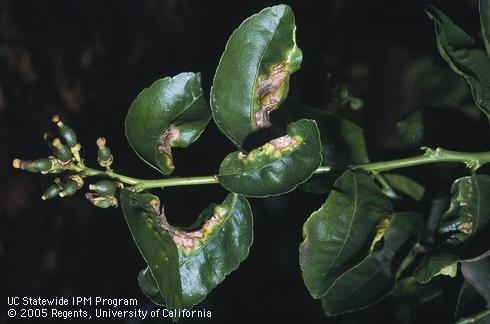Leafminer Moths
By Linda Lewis Griffith UCCE Master Gardener
What are those brown, squiggly lines on the underside of my lemon tree's leaves? James T., Oceano
Your tree probably has an infestation of citrus leafminer, a very small, light colored moth most commonly found on citrus and closely related trees, such as kumquats. The pest arrived in California from Mexico in 2000 and has spread throughout most of the state.
Citrus leafminer moths are seldom seen. They're most active from early morning to evening and spend days resting on the back of leaves.
Females lay eggs on the undersides of a tree's newest growth. The eggs hatch in 4 to 5 days and the larvae immediately begin feeding and create shallow, meandering mines. As larvae increase in size, the mines become more visible and fill with larval excrement, creating the telltale trails. Larvae molt 4 times over the next few weeks, eventually emerging from the mine as a prepupa, rolling the edges of the leaf to complete pupal development. The entire life cycle takes 3 to 7 weeks, depending on the temperature and weather conditions. Citrus leafminer is most common from mid-summer through fall and early winter.
Mature citrus trees can tolerate leafminer damage without any effect on tree growth or fruit yield. Nurseries and new plantings are more susceptible because their growth is slowed by the infestation. However, even when infestations are heavy, the trees are unlikely to die.
Because citrus leafminer are attracted to new flush of leaves, gardeners are advised to limit pruning to once a year, ensuring that cycles of flushing are uniform and short. Once citrus leaves have hardened, they're imperious to further leafminer damage. Do not prune off leaves afffected by citrus leafminer; undamaged areas of the leaves continue to produce food for the tree. In addition, avoid applying nitrogen fertilizer when leafminer numbers are high and new growth will be severely impacted.
Vigorous shoots known as water sprouts often develop on branches and above the graft union on the tree's trunk. These shoots grow rapidly and produce new leaves for a prolonged period of time. Remove water sprouts that serve as sites on which moths can lay eggs.
For more information, go to: http://ipm.ucanr.edu/PMG/PESTNOTES/pn74137.html
Don't miss our 11th annual Tomato Extravaganza and Plant Sale on Saturday August 19, 10:00 to 2:00 p.m. at 2156 Sierra Way, San Luis Obispo.
